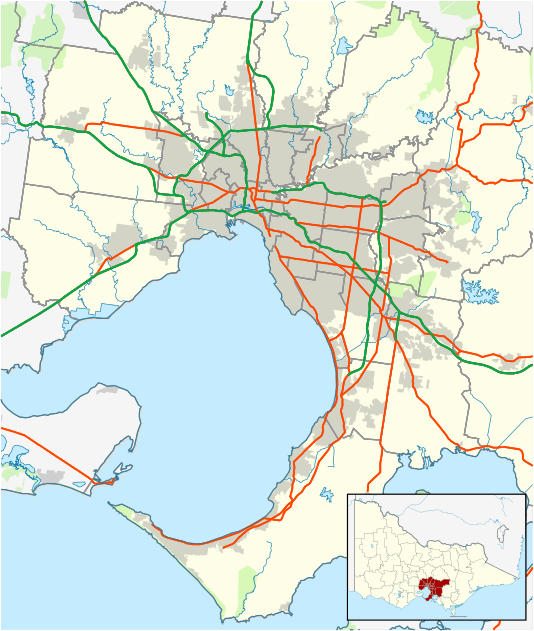Caulfield, Victoria
| Caulfield Melbourne, Victoria | |||||||||||||
|---|---|---|---|---|---|---|---|---|---|---|---|---|---|
 Caulfield | |||||||||||||
| Coordinates | 37°53′02″S 145°01′36″E / 37.884°S 145.0266°ECoordinates: 37°53′02″S 145°01′36″E / 37.884°S 145.0266°E | ||||||||||||
| Population | 5,160 (2011 census)[1] | ||||||||||||
| • Density | 3,440/km2 (8,910/sq mi) | ||||||||||||
| Postcode(s) | 3162 | ||||||||||||
| Area | 1.5 km2 (0.6 sq mi) | ||||||||||||
| Location | 12 km (7 mi) from Melbourne | ||||||||||||
| LGA(s) | City of Glen Eira | ||||||||||||
| State electorate(s) | Caulfield | ||||||||||||
| Federal Division(s) | Melbourne Ports | ||||||||||||
| |||||||||||||
Caulfield is a suburb of Melbourne, Victoria, Australia, 12 kilometres (7.5 mi) south-east of Melbourne's central business district. Its local government area is the City of Glen Eira. At the 2011 Census, Caulfield had a population of 5,160.
It is bounded by Kooyong Road in the west, Glen Eira Road in the north, Glen Huntly Road in the south and Booran Road in the east.
Caulfield is best known as the location of Caulfield Racecourse and the Caulfield campus of Monash University.
History
Toponymy
The origin of the name of Caulfield is not known for certain, but the name seemed to be linked with Baron Caulfield of Ireland, perhaps through John Caulfield, a pioneer of the colony. The name Caulfield was in use by 1853, and the early maps always place it somewhere around the racecourse.
Pre-European history
The local Yalukit people were coastal and dependent on seafoods, so few Aboriginal relics have been found in Caulfield.[2] Nevertheless, some contact did occur in the area between Aborigines and European settlers. Murrum Murrumbean was a local native from whom the placename Murrumbeena derives. Frederick Chapman (later Justice of the New Zealand Supreme Court) was able to recollect a corroboree which took place in Hotham Street, involving hundreds of Gippsland Aborigines.[2]
Establishment
In the mid nineteenth century, the Caulfield area was swampy, low-lying ground. It served as watering and pasture land for the pastoralists driving stock from Gippsland to Melbourne.[2] In the 1840s, several distinct communities had arisen throughout the area. Owensville was located around the western end of Glen Eira Road. Alma Road Village was another middle class area further north. Camden Town was a working class area at the junction of Glen Huntly and Hawthorn Roads. Meanwhile, the area south of Paddy's Swamp (now Caulfield Park) developed into the main commercial area of Caulfield. Initially the Black Chapel at that point served as the area's first church. This building was soon converted to Boxill's general store.[2] The whole area was proclaimed the Caulfield Road District in 1857. It served as a location for several grand mansions for wealthy Melbourne citizens over the following decades. Caulfield Post Office opened on 1 January 1863 and closed in 1974. Caulfield Junction Post Office opened in 1923 and remains open.[3]
Parks and open space
Caulfield Park, which is nearby in Caulfield North, is a large Victorian garden flanked by Hawthorn, Balaclava and Inkerman Roads, which features a war memorial, a decorative lake and playing fields for various sports.
Public transport
Caulfield is one of Melbourne's suburbs most serviced by public transport.
Trains connect the suburb to the city via the major transport interchange, Caulfield railway station, at Caulfield East.
Trams service North South and East Caulfield extensively via route 67 (along Glen Huntly Road) route 64 (along Hawthorn Road), crossing Hawthorn Road at both Balaclava Road and Glen Huntly Road and route 3 near the railway station.
Sport
The suburb has an Australian Rules football team competing in the Southern Football League.[4]
See also
- Caulfield Racecourse
- Caulfield North, Victoria
- City of Caulfield - the former local government area
References
- ↑ Australian Bureau of Statistics (31 October 2012). "Caulfield (State Suburb)". 2011 Census QuickStats. Retrieved 11 February 2013.
- 1 2 3 4 Murray PR and Wells JC (1980), From sand, swamp and heath..., The City of Caulfield, p. 1, ISBN 978-0-9598392-6-5
- ↑ Premier Postal History, Post Office List, retrieved 11 April 2008
- ↑ Full Point Footy, Southern Football League, retrieved 21 October 2008